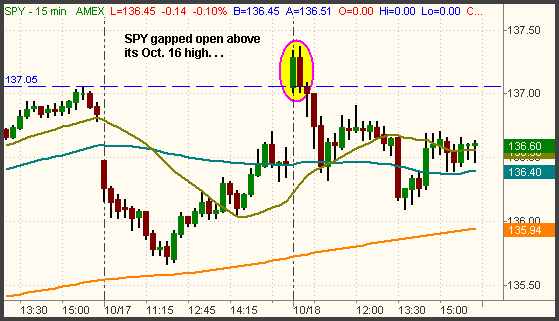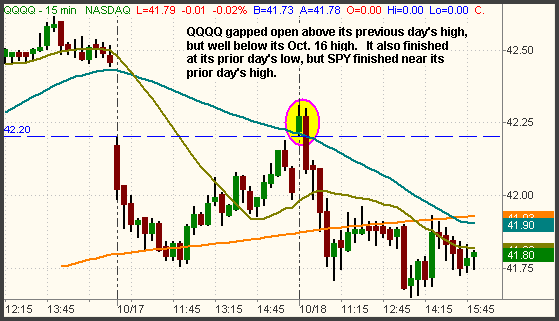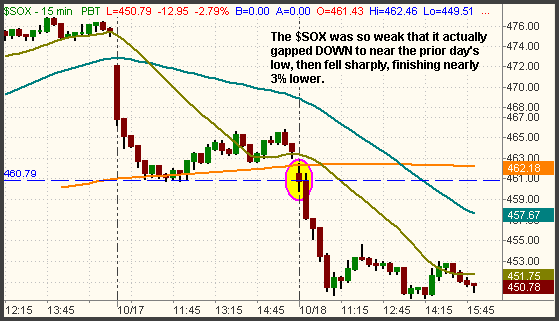The major indices followed up the previous day's losses with a large opening gap yesterday morning, but traders immediately sold into strength, causing stocks to slide into negative territory within the first hour of trading. After trading sideways for several hours, another wave of selling hit the market in the early afternoon, but a bounce around 2:30 pm EDT lifted stocks off their intraday lows. Results into the close were mixed. The Nasdaq Composite fell 0.3%, but the S&P 500 managed a 0.1% gain. The Dow finally probed above the 12,000 level intraday, but closed just below it. The blue-chip index finished 0.4% higher. Both the small-cap Russell 2000 and S&P Midcap 400 declined 0.2%.
Total volume in the NYSE increased by 7% yesterday, but turnover in the Nasdaq was 1% lighter than the previous day's level. The small drop in volume prevented the Nasdaq from having its second straight "distribution day." Despite the S&P and Dow both closing higher, declining volume in the NYSE marginally exceeded advancing volume. In the Nasdaq, declining volume exceeded advancing volume by a margin of just over 3 to 2.
There was a huge divergence between the S&P and Nasdaq that was not readily apparent simply by comparing the closing prices of the major indices. This digression was clearly apparent with the market's opening gap, and it continued throughout the entire session. To illustrate this, let's compare the intraday charts of the S&P 500 SPDR (SPY) and the Nasdaq 100 Index Tracking Stock (QQQQ). First is the chart of SPY:

Looking at the chart above, notice how SPY gapped open above not only the previous day's high, but above the October 16 high. On the open, SPY was looking great because it had completely blown off the previous day's weakness and was actually trading at a new multi-year high. But the gap quickly faded, causing SPY to trade near the flat line for most of the session before finishing fractionally higher. Now, notice the major relative weakness that plagued the Nasdaq, as represented by QQQQ:

Unlike SPY, which gapped open well above the October 16 high, QQQQ barely opened above the previous day's high. Then, when traders sold into strength of the opening gap, it caused QQQQ to drop all the way down to test support of its previous day's low. Comparatively, notice how SPY found support near the top of its previous day's range. As you can see, the relative weakness remained into the close. QQQQ closed near its prior day's low, while SPY closed near its prior day's high. If you followed yesterday's action in the Semiconductor Index ($SOX), you would know the reason for this huge divergence between the indices. Check out the intraday chart of the $SOX:

Not only did the $SOX not gap above the previous day's high, but it actually gapped down to open near the previous day's low. Fifteen minutes later, it entered into the steady downtrend that pulled the entire market with it. The index eventually finished with a 2.8% loss. The reason we showed you these three charts is to clearly illustrate the importance of the $SOX index with regard to determining the direction of the entire broad market. We talk about the $SOX index all the time because it is so heavily weighted within the Nasdaq. As the $SOX goes, the Nasdaq goes, which in turn leads the S&P and Dow. The above charts are a great example of this. When the $SOX starts a trading day so weak, it should always serve as a warning sign for any new long entries that session.
After falling 5.3% over the past two days, the $SOX now sits at support of its 50-day moving average. Yesterday, we illustrated the major resistance of its 200-day MA and prior uptrend line, but support in the $SOX should be found at its 50-day moving average, half a percent below yesterday's closing price. The S&P and Dow are doing their best to hold near their highs, but the $SOX could throw a wrench in the works if its relative weakness continues. A number of major tech companies released earnings after the close yesterday as well, so let's see how the market digests these results. When the indices are out of sync with each other, as they were yesterday, it often leads to choppy and erratic trading action, so beware of aggressively entering new positions on either side of the market right now.
Deron Wagner is the Founder and Head Trader of both Morpheus Capital LP, a U.S. hedge fund, and Morpheus Trading Group, a trader education firm launched in 2001 that provides daily technical analysis of the leading ETFs and stocks. For a free trial to the full version of The Wagner Daily or to learn about Wagner's other services, visit MorpheusTrading.com or send an e-mail to deron@morpheustrading.com.